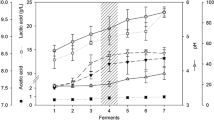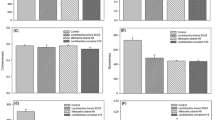Abstract
Quinoa fermentation by lactic acid bacteria (LAB) is an interesting alternative to produce new bakery products with high nutritional value; furthermore, they are suitable for celiac patients because this pseudo-cereal contains no gluten. Growth and lactic acid production during slurry fermentations by Lactobacillus plantarum CRL 778 were greater in quinoa (9.8 log cfu/mL, 23.1 g/L) than in wheat (8.9 log cfu/mL, 13.9 g/L). Lactic fermentation indirectly stimulated flour protein hydrolysis by endogenous proteases of both slurries. However, quinoa protein hydrolysis was faster, reaching 40–100 % at 8 h of incubation, while wheat protein hydrolysis was only 0–20 %. In addition, higher amounts of peptides (24) and free amino acids (5 g/L) were determined in quinoa compared to wheat. Consequently, greater concentrations (approx. 2.6-fold) of the antifungal compounds (phenyllactic and hydroxyphenyllactic acids) were synthesized from Phe and Tyr in quinoa by L. plantarum CRL 778, an antifungal strain. These promising results suggest that this LAB strain could be used in the formulation of quinoa sourdough to obtain baked goods with improved nutritional quality and shelf life, suitable for celiac patients.





Similar content being viewed by others
References
Aguirre L, Garro MS, Savoy De Giori G (2008) Enzymatic hydrolysis of soybean protein using lactic acid bacteria. Food Chem 111:976–982
Alvarez-Jubete A, Auty M, Arendt EK, Gallagher E (2010) Baking properties and microstructure of pseudocereal flours in gluten-free bread formulations. Eur Food Res Technol 230:437–445
Baer A, Ryba I, Meyer J, Butikofer U (1996) Microplate assay of free amino acids in Swiss cheeses. Food Sci Technol 29:58–62
Bhargava A, Shukla S, Ohri D (2006) Chenopodium quinoa—an Indian perspective. Ind Crop Prod 23:73–87
Bicudo MOP, Vasques EC, Zuim DR, Candido LMB (2012) Elaboration and characterization of fermented drink from quinoa water soluble extract and pulp fruit. B CEPPA 30:19–26
Bleukx W, Delcour JA (2000) A second aspartic proteinase associated with wheat gluten. J Cereal Sci 32:31–42
Bleukx W, Brijs K, Torrekens S, Van Leuven F, Delcour JA (1998) Specificity of a wheat gluten aspartic proteinase. Biochim Biophys Acta 1387:317–324
Borges JT, Bonomo RC, Paula CD, Oliveira L, Cesário MC (2010) Características físico-químicas, nutricionais e formas de consumo da quinoa (Chenopodium quinoa Willd.). Temas Agrarios 15:9–23
Bradford MM (1976) A rapid and sensitive method for the quantitation of microgram quantities of protein utilizing the principle of protein-dye binding. Anal Biochem 72:248–254
Brinegar C, Goundan S (1993) Isolation and characterization of chenopodin, the 11S seed storage protein of quinoa (Chenopodium quinoa). J Agric Food Chem 41:182–185
Brown JWS, Ersland DR, Hall TC (1982) Molecular aspects of storage protein synthesis during seed development. In: Khan AA (ed) The physiology and biochemistry of seed development, dormancy, and germination. Elsevier, New York, pp 3–42
Clarke CI, Schober TJ, Dockery P, O’Sullivan K, Arendt EK (2004) Wheat sourdough fermentation: effects of time and acidification on fundamental rheological properties. Cereal Chem 81:409–417
Coda R, Rizzello CG, Gobbetti M (2010) Use of sourdough fermentation and pseudo-cereals and leguminous flours for the making of a functional bread enriched of γ-aminobutyric acid (GABA). J Food Microbiol 137:236–245
Dallagnol AM, Font de Valdez G, Catalán C, Mercado MI, Rollán G (2011) Effect of biosynthetic intermediates and citrate on the phenyllactic and hydroxyphenyllactic acids production by Lactobacillus plantarum CRL 778. J Appl Microbiol 111:1447–1455
De Meo B, Freeman G, Marconi O, Booer C, Perretti G, Fantozzi P (2011) Behaviour of malted cereals and pseudo-cereals for gluten-free beer production. J Inst Brew 117:541–546
De Vuyst L, Neysens P (2005) The sourdough microflora: biodiversity and metabolic interactions. Trends Food Sci Technol 16:43–56
De Vuyst L, Vancanneyt M (2005) Biodiversity and identification of sourdough lactic acid bacteria. Food Microbiol 24:120–127
Di Cagno R, De Angelis M, Lavermicocca P, De Vincenzi M, Giovannini C, Faccia M, Gobbetti M (2002) Proteolysis by sourdough lactic acid bacteria: effects on wheat flour protein fractions and gliadin peptides involved in human cereal intolerance. Appl Environ Microbiol 68:623–633
Edema MO, Sanni LO, Sanni AI (2005) Evaluation of maize–soybean flour blends for sour maize bread production in Nigeria. Afr J Biotechnol 4:911–918
Enriquez N, Peltzer M, Raimundi A, Tosi V, Pollio ML (2003) Characterization of wheat and quinoa flour in relation to their breadmaking quality. J Argent Chem Soc 91:47–54
Gänzle MG, Loponen J, Gobbetti M (2008) Proteolysis in sourdough fermentations: mechanisms and potential for improved bread quality. Trends Food Sci Technol 19:513–521
Gerez CL, Rollán GC, De Valdez GF (2006) Gluten breakdown by lactobacilli and pediococci strains isolated from sourdough. Lett Appl Microbiol 42(5):459–464
Gerez CL, Torino MI, Rollán GC, Font de Valdez G (2009) Prevention of bread mould spoilage by using lactic acid bacteria with antifungal properties. Food Control 20:144–148
Gerez CL, Torino MI, Obregozo MD, Font de Valdez G (2010) A ready-to-use antifungal starter culture improves the shelf life of packaged bread. J Food Prot 73:758–762
Gerez CL, Dallagnol AM, Rollán G, Font de Valdez G (2012) A combination of two lactic acid bacteria improves the hydrolysis of gliadin during wheat dough fermentation. Food Microbiol 32:427–430
Gobbetti M (1998) The sourdough microflora: interactions of lactic acid bacteria and yeasts. Trends Food Sci Technol 9:267–274
Gorinstein S, Pawelzik E, Delgado-Licon E, Haruenkit R, Weisz M, Trakhtenberg S (2002) Characterization of pseudocereal and cereal proteins by protein and amino acid analyses. J Sci Food Agric 82:886–891
Hager AS, Wolter A, Czerny M, Bez J, Zannini E, Arendt EK, Czerny M (2012) Investigation of product quality, sensory profile and ultrastructure of breads made from a range of commercial gluten-free flours compared to their wheat counterparts. Eur Food Res Technol 235:333–344
Hebert EM, Raya RR, De Giori GS (2000) Nutritional requirements and nitrogen-dependent regulation of proteinase activity of Lactobacillus helveticus CRL 1062. Appl Environ Microbiol 66:5316–5321
Ju ZY, Hettiarachchy NS, Rath N (2001) Extraction, denaturation and hydrophobic properties of rice flour proteins. Food Chem Toxicol 66:229–232
Kleerebezem M, Boekhorst J, Van Kranenburg R, Molenaar D, Kuipers OP, Leer R, Tarchini R, Peters SA, Sandbrink HM, Fiers MW, Stiekema W, Lankhorst RM, Bron PA, Hoffer SM, Groot MN, Kerkhoven R, De Vries M, Ursing B, De Vos WM, Siezen RJ (2003) Complete genome sequence of Lactobacillus plantarum WCFS1. Proc Natl Acad Sci U S A 100:1990–1995
Laemmli UK (1970) Cleavage of structural proteins during the assembly of the head of bacteriophage T4. Nature 227:680–685
Lagrain B, Goderis B, Brijs K, Delcour JA (2010) Molecular basis of processing wheat gluten toward biobased materials. Biomacromolecules 11:533–541
Lee K, Lee J, Kim YH, Moon SH, Park YH (2001) Unique properties of four lactobacilli in amino acid production and symbiotic mixed culture for lactic acid biosynthesis. Curr Microbiol 43:383–390
Loponen J, Mikola M, Katina K, Sontag-Strohm T, Salovaara H (2004) Degradation of HMW glutenins during wheat sourdough fermentations. Cereal Chem 81:87–93
Lorenz K, Nyanzi F (1989) Enzyme activities in quinoa (Chenopodium quinoa). Int J Food Sci Technol 24:543–551
Loscalzo J (2004) l-Arginine and atherothrombosis. J Nutr 134:2798–2800
Milesi MM, McSweeney PL, Hynes ER (2008) Viability and contribution to proteolysis of an adjunct culture of Lactobacillus plantarum in two model cheese systems: cheddar cheese-type and soft-cheese type. J Appl Microbiol 105:884–892
Minervini F, De Angelis M, Di Cagno R, Pinto D, Siragusa S, Rizzello CG, Gobbetti M (2010) Robustness of Lactobacillus plantarum starters during daily propagation of wheat flour sourdough type I. Food Microbiol 27:897–908
Moore MM, Dal Bello F, Arendt EK (2008) Sourdough fermented by Lactobacillus plantarum FST 1.7 improves the quality and shelf life of gluten-free bread. Eur Food Res Technol 226:1309–1316
Moroni AV, Dal Bello F, Arendt EK (2009) Sourdough in gluten-free bread-making: an ancient technology to solve a novel issue? Food Microbiol 26:676–684
Mujica A, Jacobsen SE (2006) La quinua (Chenopodium quinoa Willd.) y sus parientes silvestres. In: Moraes RM, Øllgaard B, Kvist LP, Borchsenius F, Balslev H (eds) Botánica Económica de los Andes Centrales. Instituto de Ecología UMSA, Bolivia, pp 449–457
Playne MJ, McDonald P (1966) The buffering constituents of herbage and of silage. J Sci Food Agric 17:264–268
Poutanen K, Flander L, Katina K (2009) Sourdough and cereal fermentation in a nutritional perspective. Food Microbiol 26:693–699
Ranhotra GS, Gelroth JA, Glaser BK, Lorenz KJ, Johnson DL (1993) Composition and protein nutritional quality of quinoa. Cereal Chem 70:103–105
Repo-Carrasco R, Espinoza C, Jacobsen SE (2003) Nutritional value and use of the Andean crops quinoa (Chenopodium quinoa) and kaniwa (Chenopodium pallidicaule). Food Rev Int 19:179–189
Ruales J, Nair BM (1994) Effect of processing on in vitro digestibility of protein and starch in quinoa seeds. Int J Food Sci Technol 42:1–11
Schagger H, Von Jagow G (1987) Tricine–sodium dodecyl sulfate-ployacrylamide gel electrophoresis for the separation of proteins in the range from 1 to 100 kDa. Anal Biochem 166:368–379
Thiele C, Gänzle MG, Vogel RF (2002) Contribution of sourdough lactobacilli, yeast and cereal enzymes to the generation of amino acids in dough relevant for bread flavour. Cereal Chem 79:45–51
Valerio F, Lavermicocca P, Pascale M, Visconti A (2004) Production of phenyllactic acid by lactic acid bacteria: an approach to the selection of strains contributing to food quality and preservation. FEMS Microbiol Lett 233:289–295
Van der Meulen R, Grosu-Tudor S, Mozzi F, Vaningelgem F, Zamfir M, Font de Valdez G, De Vuyst L (2007) Screening of lactic acid bacteria isolates from dairy and cereal products for exopolysaccharide production and genes involved. Int J Food Microbiol 118:250–258
Vega-Gálvez A, Miranda M, Vergara J, Uribe E, Puente L, Martínez EA (2010) Nutrition facts and functional potential of quinoa (Chenopodium quinoa Willd.), an ancient Andean grain: a review. J Sci Food Agric 90:2541–2547
Vermeulen N, Gänzle MG, Vogel RF (2006) Influence of peptide supply and co-substrates on phenylalanine metabolism of Lactobacillus sanfranciscensis DSM20451 and Lactobacillus plantarum TMW1.468. J Agric Food Chem 54:3832–3839
Watford M (2008) Glutamine metabolism and function in relation to proline synthesis and the safety of glutamine and proline supplementation. J Nutr 138:2003–2007
Wick M, Böcker G, Stolz P, Lebault JM (2003) Influence of several process parameters on sourdough fermentation. Acta Biotechnol 23:51–61
Wu G (2010) Functional amino acids in growth, reproduction, and health. Adv Nutr 1:31–37
Zotta T, Piraino P, Ricciardi A, McSweeney PL, Parente E (2006) Proteolysis in model sourdough fermentations. J Agric Food Chem 54:2567–2574
Acknowledgments
We acknowledge the financial support of Consejo Nacional de Investigaciones Científicas y Técnicas (CONICET), Agencia Nacional de Promoción Científica y Tecnológica (ANPCyT), Consejo de Investigaciones de la Universidad Nacional de Tucumán (CIUNT), and Ministerio de Ciencia, Tecnología e Innovación Productiva (MINCyT) from Argentina. We thank Dr. Fernanda Mozzi and Dr. Raúl Raya (Centro de Referencia para Lactobacilos, Argentina) for helpful suggestions and Dr. Jorge Palacios for the technical support.
Author information
Authors and Affiliations
Corresponding author
Rights and permissions
About this article
Cite this article
Dallagnol, A.M., Pescuma, M., De Valdez, G.F. et al. Fermentation of quinoa and wheat slurries by Lactobacillus plantarum CRL 778: proteolytic activity. Appl Microbiol Biotechnol 97, 3129–3140 (2013). https://doi.org/10.1007/s00253-012-4520-3
Received:
Revised:
Accepted:
Published:
Issue Date:
DOI: https://doi.org/10.1007/s00253-012-4520-3




